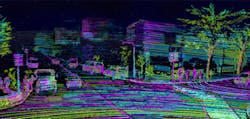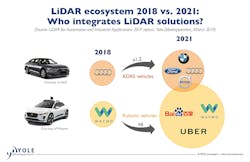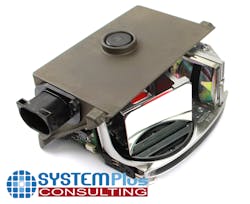Yole Anticipates $6B Market for Autonomous-Vehicle LiDAR in Five Years
The LiDAR market was worth $1.3 billion in 2018, according to market research firm Yole Développement (Lyon, France), which recently released the findings of two 2019 studies (LiDAR for Automotive & Industrial Applications, and Radar & Wireless for Automotive: Market and Technology Trends). The company expects the LiDAR market will be upwards of $6 billion by 2024, with 70% of the total market dedicated to automotive applications.
Driven by lower production costs and the emergence of new technologies, Yole expects the LiDAR market “to explode, with a 64% CAGR between 2018 and 2024.” This growth will serve both the robo-taxi segment and the ADAS vehicle segment (Fig. 1). And, in the view of the market research organization, it will require development of new technologies as LiDAR is a critical element in the fusion of sensors required for self-driving vehicles.
1. According to Yole, the LiDAR market will “explode.” (Source: Yole Développement)
For autonomous cars, the LiDAR component must have the ability to range to long distances even when observing very-low reflectivity targets and in challenging environments. In these conditions, the goal is to achieve object detection with a very limited number of photons from the return signal.
One way to achieve that goal is to use a silicon-photomultiplier (SiPM) sensor. The SiPM sensor is a low-light device that addresses the challenge of sensing, timing, and quantifying signals down to the single-photon level. Traditionally a job left to photomultiplier tubes (PMTs), SiPM offers an alternative that combines the low-light detection capabilities of the PMT while offering the benefits of a solid-state sensor. Research studies have shown that SiPM can offer suitable capabilities for use as a photodetector for time-of-flight (ToF) LiDARs in autonomous vehicles, enabling >100-m ranging with low reflectivity targets.
LiDAR Sensor Apps
With an estimated 85 companies developing automotive-grade LiDAR products, different types of sensors may emerge. LiDAR, for example, may evolve into a camera-and-laser technology. In operation, light would be is emitted in bright pulses across a broad area, and cameras would record not just how much light they receive, but also when they receive it (with nanosecond precision).
In 3D Flash LiDAR, a single laser pulse per frame of data delivers range data and black-and-white video back to the LiDAR sensor, where they’re captured by a focal plane array of smart pixels. The system employs a single photon avalanche diode (SPAD) array and distance measurement is based on first-photon ToF. The arrays don’t capture just one point like they do in traditional LiDAR—each individual pixel provides position information.
Such technology could help enable a significantly more detailed and accurate field of vision around the entire vehicle, independent of day or nighttime or adverse weather conditions. The sensor and evaluation electronics also could be mounted on the same chip, reducing space requirements.
Then and Now
Automotive LiDAR traces its existence back to the DARPA2 Grand Challenge, an autonomous vehicle race to encourage development of fully autonomous ground vehicles. In 2005, for the second instance of that race, LiDAR was introduced. Two years later, in 2007, five of the six vehicles finishing that race embedded LiDAR on the roof. Since then, many companies have made their own prototypes of autonomous vehicles using LiDAR, and carmakers have showed great interest in this technology.
“Waymo has a fleet of more than 600 vehicles today,” said Alexis Debray, PhD, Technology & Market Analyst at Yole. “Several announcements have been made about increasing this number up to 82,000 vehicles using Chrysler Pacifica Hybrid minivans and Jaguar I-Pace SUVs.”
On the carmaker side, Audi integrated a LiDAR supplied by Valeo in its A8 since the end of 2017. It’s now expanding this feature as an option in other vehicles such as the Q8, A7 and A6.
System Plus Consulting, part of Yole group of companies, analyzed the laser scanner developed via the partnership between Valeo and Ibeo. Named SCALA, this mechanical 3D scanner laser is capable of identifying objects and measuring distance in any environment (Fig. 2).
2. Valeo’s SCALA scans the area in front of the vehicle and detects other vehicles, motorbikes, pedestrians, and static obstacles. Using the collected data, the scanner enables the creation of a map of the environment. (Source: System Plus Consulting)
“An embedded rotating mirror deflects the beam emitted by a high-power laser diode through an emitting lens and receives the returned reflections through a condenser lens”, explained Sylvain Hallereau, Project Manager in charge of costing analyses at System Plus Consulting. “A three-element avalanche photodiode array then captures the reflections. ToF measurement of the travel time of this pulse enables the system to determine distance from the obstacle.”
According to System Plus, the laser selected by Valeo is a high-power pulsed laser diode based on technology from Laser Components. The three stacked active layers deliver a peak power of 75 W in 150-ns long pulses. In parallel, ToF is measured by an avalanche photodiode array developed by First Sensor.



